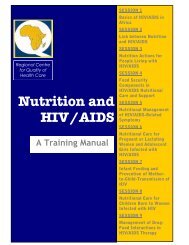2.1: Anthropometric Indicators Measurement Guide - Linkages Project
2.1: Anthropometric Indicators Measurement Guide - Linkages Project
2.1: Anthropometric Indicators Measurement Guide - Linkages Project
Create successful ePaper yourself
Turn your PDF publications into a flip-book with our unique Google optimized e-Paper software.
APPENDIX<br />
1.Calculating<br />
Z-scores<br />
9.<br />
Using Distributions by Standard Deviation<br />
The reference population data are<br />
available with the mean measurement<br />
values and the measurement values for up<br />
to +/- 3SD displayed, for the three<br />
nutritional status indices. These values<br />
are given for each month of age up to 119<br />
months, for both boys and girls. The data<br />
may be viewed in the following three<br />
formats: (1) table; (2) graph; and (3)<br />
spreadsheet. An example of how a table of<br />
weight-for-age values for boys can be used<br />
is as follows.<br />
Procedure<br />
A 19-month-old boy who weighs 9.8 kg is<br />
compared to the reference standards. Use a<br />
distribution of the reference standards that<br />
already has values for the standard<br />
deviations calculated. First, the appropriate<br />
distribution should be consulted.<br />
Example: Part of the table below is the<br />
weight-for-age by standard deviation for<br />
boys. Age in months is listed in the far left<br />
column. The mean or expected values for<br />
an “average” healthy boy of each age is<br />
located in the middle column. The<br />
measurement values range from -3 to +3<br />
SDs, with the standard deviation for the<br />
lower and upper halves of the distribution<br />
also shown. The correct line of the table<br />
should be found (lines vary by months of<br />
age or centimeters of length). The child’s<br />
measurement should then be pinpointed<br />
along this line.<br />
Example: In this case, we need to locate<br />
the line for the age 19 months and then<br />
find where 9.8 kg falls. The table shows<br />
that such a child falls between -2 and -1<br />
SD.<br />
Therefore, we would say that a 19 month<br />
old boy who weighed 9.8 kg is between -2<br />
and -1 SD from the mean. To obtain a<br />
more accurate statistic, a Z-score would<br />
have to be calculated.<br />
Calculating Z-scores<br />
When the mean and standard deviation<br />
for a set of data are available, as they are<br />
with the reference standards, a Z-score<br />
can be calculated. In this case, a Z-score<br />
calculated for an individual tells exactly<br />
how many standard deviation units his<br />
measurements are away from the mean of<br />
the reference distribution. A positive Z-<br />
score means that an individual’s<br />
measurements are higher than the<br />
reference mean and a negative Z-score<br />
means that the measurements are lower<br />
than the reference mean. The advantage<br />
of calculating a Z-score is that it provides<br />
more precision than just locating a<br />
position on a table, as we did above. Only<br />
the mean and standard deviation are<br />
needed.<br />
Procedure<br />
Assume we have the same 19 month old<br />
boy from the example above, who weighs<br />
9.8 kilograms. If we look at the reference<br />
64

















